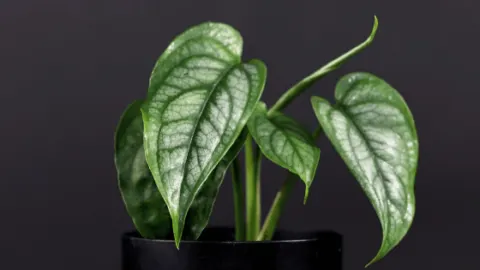Monstera siltepecana or Monstera siltepecana silver belongs to the Monstera genus and was first collected in 1889 in Guatemala by John Donnell Smith, according to A Revision to Monstera – Madison (Aroid.org). It is also known as Silver Monstera.
The Monstera genus consists of at least 50 different species of flowering plants.
Here is all you need to know about Monstera siltepecana care.
Monstera siltepecana Care Takeaways
| Species | Monstera siltepecana |
| Synonyms | Silver Monstera |
| Family | Araceae |
| Genus | Monstera |
| Growth | Climbing, vining |
| Height | 12 feet |
| Width | 4 feet |
| Soil | Chunky Aroid soil |
| Watering | Water every 5 to 7 days |
| Light | Bright indirect |
| Temperature | 60 to 95°F |
| Humidity | 60-80% |
| Fertilizer | Fertilize once a month in spring and summer |
| Propagation | Stem cuttings, seeds |
Table of Contents
Monstera siltepecana Care
To care for Monstera siltepecana water once the top 2″ (5cm) of the soil (5cm) almost dry out every 5-7 days. Keep the temperature between 60-95°F (16°C -35°C). Provide well-draining aroid mix using peat moss, bark, perlite, and charcoal, as well as bright indirect light. Provide >60% humidity. Use a balanced fertilizer at 1/2 strength monthly in the growing season.
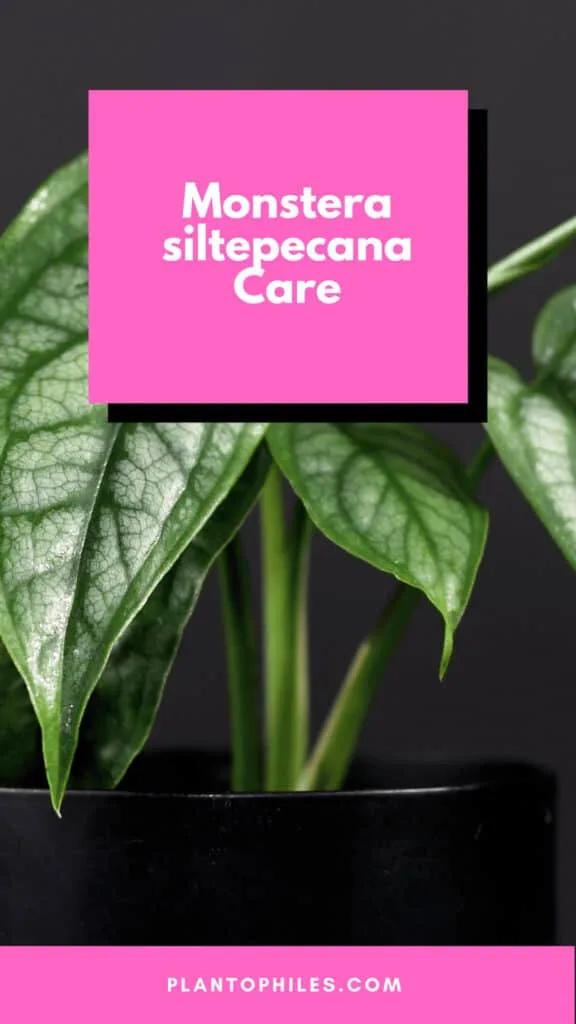
What is Monstera siltepecana?
Monstera siltepecana is a Monstera species with slender green and silver-grey marked. The leaves have a silvery shine. It is native to Mexico and Central America.
Have a look at the other Monstera articles that I have already written about:
- Monstera adansonii
- Monstera deliciosa
- Monstera deliciosa Variegata
- Monstera esqueleto (previously called Monstera Epipremnoides)
- Monstera obliqua
It is no secret that I am a big fan of the Monstera genus and the Araceae family.
The Philodendron genus is also part of this very family.
Examples of Philodendrons are Philodendron gloriosum and Philodendron scandens.
But this article is dedicated to the Monstera siltepecana, a beautiful and smaller-leaved trailing plant.
It is somewhat rarer to find as some of the other Monstera and certainly stays smaller than most.
It has green leaves with dark green veins and silvery patches. Provide it with a moss people and it will climb.
However, the Monstera siltepecana will also trail if you let it hang freely.
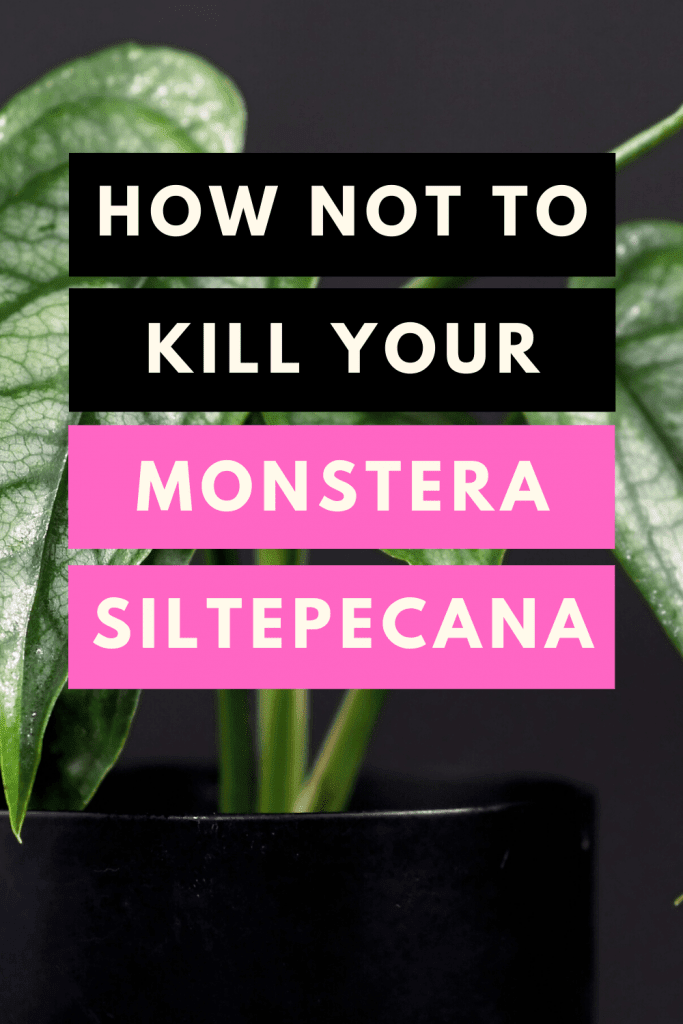
Monstera siltepecana soil
Monstera Siltepecana needs a well-draining potting mix. A general aroid mix with chunky bits using peat moss, perlite, and pumice, as well as orchid bark pieces and charcoal, is best.
Read our article about how to produce an airy houseplant soil mix.
You can also use some sphagnum moss in our soil mix so it will retain a certain level of humidity for a prolonged time.
It is essential to use chunky bits, as well as air pockets, are essential for the roots of your Monstera siltepecana.
They need oxygen; otherwise, they will rot. Root rot is often caused by compacted soil.
This is very important.
If the soil is too dense, you will run into problems.
Monstera plants are mostly epiphytes not used to fully covering their roots in dense soil.
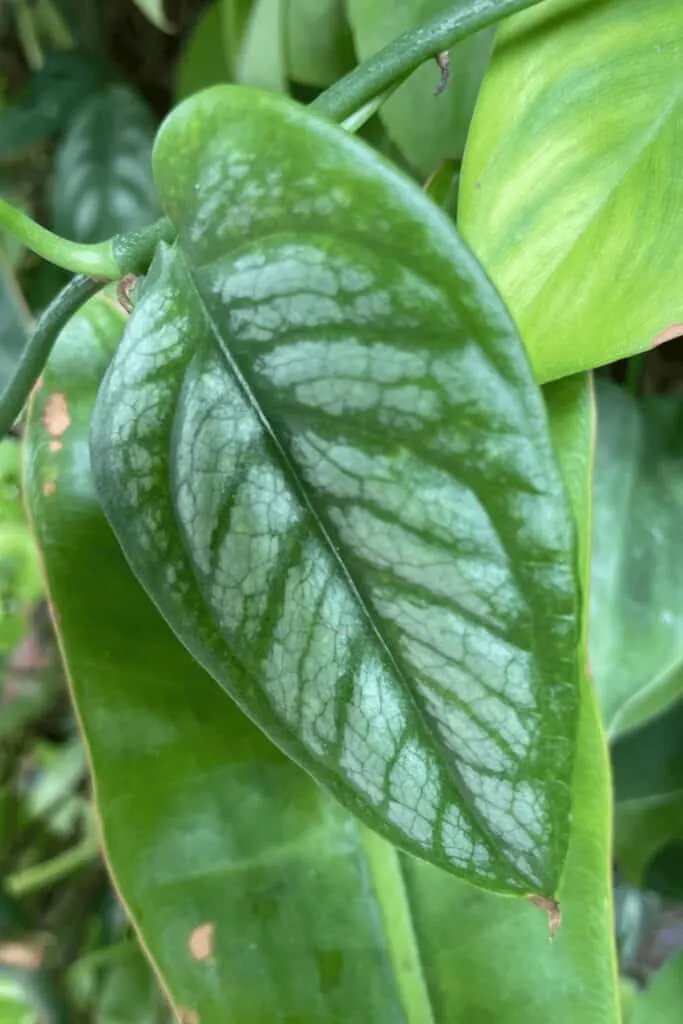
Monstera siltepecana light
Bright indirect sunlight is best for your Monstera siltepecana.
As with most Monstera, a few hours of direct sunlight in the morning are no problem.
Especially when direct sunlight is in the mornings, this is the case with an east-facing window.
Read our article about the different window directions and their impact on the best light levels for your plants.
Monstera siltepecana also does well in partial or full shade in nature. It tolerates lower light conditions.
However, if you care for your plant as a houseplant, we recommend putting it close to a window where it gets bright indirect light.
This way, your plants will thrive and grow well, and you will not risk leaf burn. This can happen if you provide too much direct sunlight—Eg. multiple hours of strong direct afternoon sun.
Watering
Water Monstera siltepecana whenever the soil turns from slightly moist to dry. Water every 5 to 7 days.
Monstera siltepecana is home to tropical forests and needs a good amount of water to thrive. Avoid soggy soil.
Otherwise, it will quickly lead to root rot.
We dedicated a whole article to root rot and how to spot it as well as how to treat root rot.
Do not wait until the topsoil is completely dry. The soil should stay slightly moist. Water once a week as a general rule.
Decrease the days between waterings if you live somewhere where it is very dry and war. Always use your index finger to check the soil before watering your plant.
No humidity meter or rule of thumb will beat that simple test.
Temperature
The best temperature range for Monstera siltepecana is 60-95°F (16°C -35°C).
These plants can be grown outside in USDA hardiness zones between 9b – 11 according to the United States Department of Agriculture Hardiness zones.
Humidity
Monstera siltepecana prefers high humidity above 60%. These plants are from tropical rainforests.
But as with almost all other Monstera with the exception of Monstera Obliqua, it will also grow in lower humidity in the fifties or even lower.
But if you are keen to offer optimal humidity conditions for your Monstera siltepecana you need to increase the air humidity indoors one way or the other. Unless you live in the tropics of course.
The following methods are known to increase the humidity of your plant:
- Put plants densely together. This will increase the humidity by several percent
- Make use of a pebble try filled with water underneath your Monstera siltepecana
- Spray the leaves of your Monstera daily
- Make use of a humidifier
- Make the bathroom the home of your Monstera siltepecana. We wrote a whole article about the best plants for your bathroom.
Any or all of these methods in combination can increase the humidity and will lead to better growth.
Fertilizer
For Monstera siltepecana use a balanced fertilizer and dilute it to half strength once a month in the growing season.
You can either make use of liquid fertilizer. If that is the case half strength is best.
An alternative is using slow-release fertilizer.
This fertilizer often comes in small roundish balls that have multiple colors.
You can have a look at our extensive houseplant fertilization guide. An NPK ratio gives nutrients in fertilizers.
NPK stands for the macronutrients: nitrogen (N), phosphorus (P), and potassium (K).
Fertilize monthly in summer and spring and reduce fertilizing in autumn and winter.
Monstera siltepecana propagation
The easiest way propagating Monstera siltepecana is by taking stem cuttings.
To propagate Monstera plants, you must ensure that you have at least one node. Nodes are these nubby spots on the stem of your plant.
To set the record straight. Single leaves without a node will never. They will never turn into a full plant. They do not have the necessary biological preconditions to do so. For a Monstera siltepecana cutting to grow into a plant, a node is needed. It can be propagated without a leaf but not without a node.
I think we made this point clear enough. In order to propagate, we recommend a stem cutting with at least one node and 1-3 leaves.
Put your cutting either into water, directly into the soil, in sphagnum moss or into pumice. We have dedicated a whole section below to give you an in-depth step-by-step instructions for each method.
Growth
When the Monstera siltepecana is small its leaves have a blueish tone with silver patches.
The more mature these plants get, the more these markings are going to go away.

Monstera siltepecana is one of these Monsteras where the mature leaves and plants look quite different from the juvenile version.
Mature Monstera siltepecana has big leaves with holes close to the midrib. It will only produce more mature leaves and grow bigger if allowed to climb. Small leaves do not fenestrate.
It will take 2-3 years for these plants to reach maturity in ideal conditions.
As a juvenile Monstera siltepecana are great plants for terrariums.
Provide your Monstera with a climbing pole such as a moss pole. This way, your plant will get bigger and bigger leaves and will mature. Otherwise, it will stay small and will show no significant growth in leaf size.
In nature, Monstera siltepecana quickly climbs trees and turns into an epiphyte.
Potting
How do you pot a Monstera siltepecana? Well, the pot itself is not so important as long as it has drainage holes. It is essential that excess water can drain quickly.
The reason is that you are supposed to water your plant thoroughly. You will want to see the water to emerge quickly through the drainage holes of your pot.
That doesn’t not only indicate that the potting soil you are using is airy and well-draining but also that no excess water will remain at the bottom of your pot.
Put some big stone or some sort of net onto the drainage holes so you are not slowly flushing out all of your potting mix.
A cachepot underneath is a good idea too. This way you don’t have to use your think or bathroom for this procedure.
You can empty the cache pot after you water your Monstera siltepecana plant.
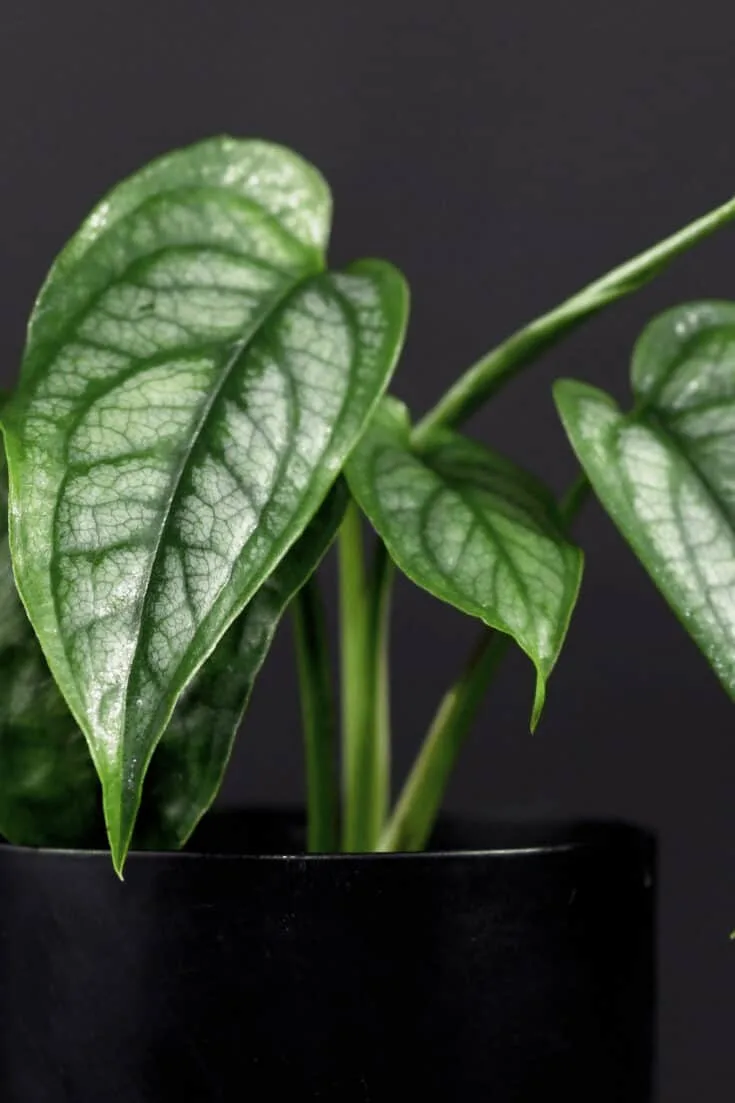
THE WATERING BASICS FOR MONSTERA SILTEPECANA PLANTS
Get watering right is probably the most essential skill you need to master if you want to keep your houseplants healthy long term.
And it is probably the easiest to get wrong. More water is not always better. Overwatering is most likely the worst thing you can do to your indoor plants. More plants die every day from overwatering compared to underwatering.
Some rule of thumbs are. When you are watering do it right. We want to see water flowing out of the drainage holes and we want you to water your plants thoroughly. This especially the case for your Monstera siltepecana.
Ok let’s summarize the most important rules when watering:
- Water in the morning and not in the evenings. This helps your plants to process the water during day time. Let them sleep at night
- Use room temperature water. Too cold or too hot water will damage the roots of your Monstera siltepecana
MONSTERA SILTEPECANA PLANT PROPAGATION TECHNIQUES
Stem cuttings best propagate this aroid with at least one node and 1-3 leaves.
The right propagation medium is mostly up to personal preferences and the availability of certain ingredients.
We prepared step by step instructions for the most common ways to copy your plant:
Water propagation
Water propagation works well in most cases and has the advantage that you can observe the process pretty well.
Many people ask why you can put plants into straight water and the do not rot.
If you put your plants into the soil and overwater, the roots quickly rot.
The reason is that the reaction between soil and too much water leads to rot.
Let’s now have a look at how you can propagate a Monstera siltepecana using the water propagation method by following the Step-by-Step instructions below.
Step-by-step instructions:
- Prepare a disinfected and sterilized knife or scissors. Use rubbing alcohol and hold the blade under a flame for several seconds. This way you ensure that you are not contaminating the motor plant.
- Make a cutting below a node with clean scissors or knife
- Prepare a vessel with room-temperature water.
- The best water to use is distilled water or rainwater. However, tap water will be fine.
- Put the cutting straight into the water
- Ensure no leaves are submerged, as this might lead to rot.
- Change the water every couple of days to ensure it stays fresh
- Oxygen in the water will speed up the rooting process
- Wait for your Monstera siltepecana to produce new roots
- After 2-3 weeks, roots will start to emerge.
- When the roots are several inches long you can now plant your Monstera into the soil
- Congratulations you copied your Siltepecana!
Soil propagation
Soil propagation, from our perspective, is the easiest and hardest method to clone your Monstera siltepecana at the same time.
Easy as it entails nothing more than just sticking your cutting into the dirt.
Hard as you have almost no way to know what is going on below the soil, and it is easy to get the humidity in the soil wrong. This can quickly lead to a rotting plant and root rot once developed.
Step-by-step instructions:
- Take a cutting with one node and 1-3 leaves
- Let it callous over for several minutes or hours depending on the size of your cutting.
- Callous over will close the wound using plant sap. Once the end of the cutting is dry, it is time to put it into the soil.
- Some people prefer to use some cloning gel or rooting hormone. You can use it, which might help the cutting to root faster. It is not necessary, however.
- Prepare your potting medium that needs to be well-draining and slightly most.
- Use a stick to make a hole to put your cutting into
- Put the cutting into the hole and make sure no leaves are submerged
- Gently press the soil around the cutting so the steam is enclosed
- Water very sparingly! Your cutting has no roots at this stage and it will take longer until the soil drys out which shouldn’t happen when you are rooting a cutting.
- After 2-3 weeks, gently pull your cutting to check if it has started to root
- Once the first new leaf has been produced, you can be sure the cutting has successfully rooted and is now a full plant. WELL DONE!
Propagate Monstera siltepecana in Sphagnum Moss
Propagating in Sphagnum Moss is now our preferred method of rooting cuttings.
First, we didn’t quite get the hype. However, once we got it right, we were astonished by how well it worked. The success rate is high if done right.
One of the biggest advantages is that your cutting will produce soil roots, not water roots, and will have no to little shock once transplanted into soil.
Step-by-step instructions:
- Prepare the sphagnum moss. It can either be dry or live sphagnum moss—either way, you will need to soak it in water. Once you let it soak for several seconds, press the moss at least three times in your firsts. This is very important. You want your sphagnum moss just a little bit moist.
- Put the moss in a container or box
- Put in your fresh cutting
- Ensure it is in a container or covered by a plastic bag (transparent), as otherwise. Your moss will dry out very quickly!
- Check on the moss every few days, and once it is about to dry out, just gently wet it again. We recommend a spraying bottle as watering with a can or under a tap will soak the moss too much, and it can be hard to press out the extra moisture when you have a cutting in the moss already.
- Wait for 2-3 weeks. You can check on the cutting every now and then to see if roots have started to form. You probably shouldn’t do it too much as it stresses the cutting every time but we would lie if we would say we never peek
Perlite propagation
Perlite is a great medium as it is not from an organic source and has been sterilized.
It is, therefore, free of pesticides, and there is little chance that you have to deal with fungal, bacterial, or pest infestations.
This is a huge relief as that is certainly something you do not want to deal with when handling cuttings that need all their energy to grow roots and new leaves.
Step-by-step instructions:
- Get some perlite. You can order it online or buy it from a garden center
- Put it into a transparent container filled with perlite. This is how we do it. The beauty of it is that you can watch the roots grow that way
- So you now have to fill the bottom of the container with water. Fill in a few inches, but not that it reaches the base of your plant
- The perlite will soak up the water using the wicking effect and provide your siltepecana cutting with the necessary humidity.
- When the water reservoir at the bottom is empty refill it with water
- After roughly 2-3 weeks roots should be starting to form
- Wait for the roots to be a couple of inches long. Stay on the save side and wait a bit longer if you ask yourself whether the roots are already long enough to put the cutting into the soil
- Voila, a perfect clone is born
Is Monstera siltepecana rare?
Monstera siltepecana is a rare plant. It is not an expensive Monstera but it is not very common and hard to get. The price for a Monstera siltepecana is between $10-$50.
Monstera siltepecana Pests
Monstera siltepecana is prone to suffer from pest infestations. The best thing you can do to prevent an infestation of any pesky insects is to:
- Check every new plant you bring into your household thoroughly
- Have a very close look at the leaves and stems of your indoor plants every couple of days to spot pests early
- Make sure to keep your plants healthy. A healthy plant will be able to deal with infestations much better.
- Use neem oil and horticultural soap as weekly as a preventative measure
- If insect infestations get bad, use neem oil, systemic insecticide, or beneficial nematodes
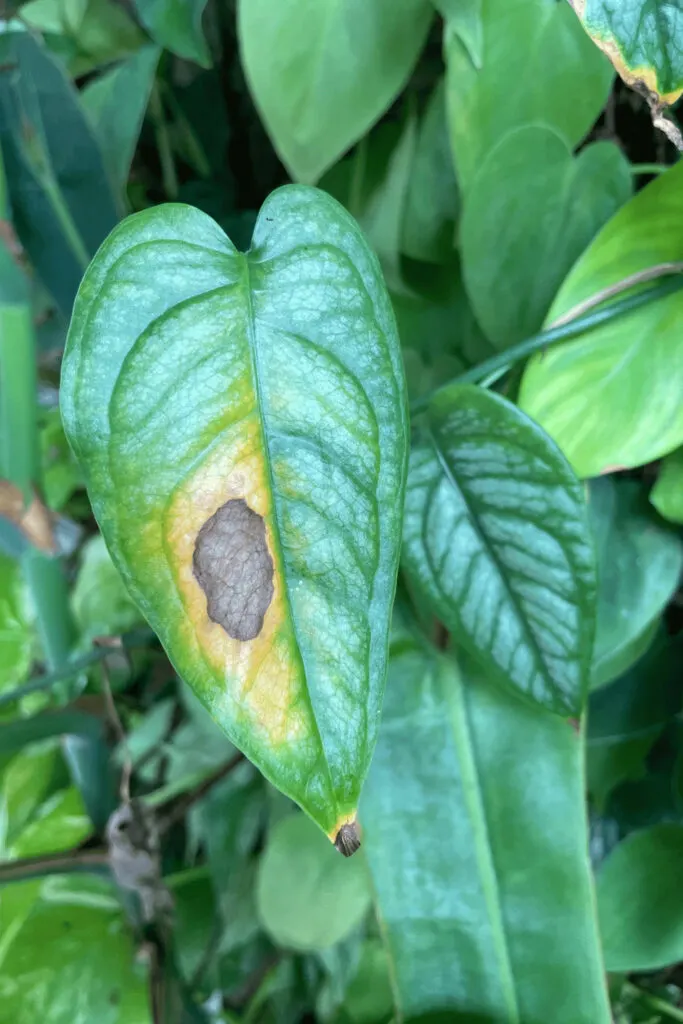
Spider mites
Spider mites can be spotted on the underside of leaves. They spin their silky webs and are rather small with a reddish color. So look out for silky-looking webs and very small red insects.
Yellow and brown spots signify the damage they cause to leaves. Besides yellowing leaves, stunted growth can be a result, and your Monstera siltepecana might eventually die if the infestations become bad.
Aphids
These are small plant sap-sucking suckers. They prefer new growth and work in colonies. They come in multiple different colors such as yellow, brown, green, brown, and black. They are very small and leaf honeydew, a sticky residue from the plant sap on the underside of leaves.
This can lead to black mold growing on leaves, and the sap will attract ants. Some of these suckers even develop wings and can thus fly.
They are neither male nor female and can reproduce without mating.
Scale
Scale is special. They do not move for the most part and stay put. They look oval and flat and are brown. As the name suggests, they have e protective shell or scale. They are often found on the stems and undersides of the leaves of your Monstera Siltepecana.
Mealybugs
When hearing the term mealy bugs you can see gardeners and indoor plant enthusiasts lose it.
I have fought many fights against these pesky insects.
Unfortunately, I cannot say that I won all of them. But at least they are still ongoing.
Mealybugs are white little insects that again prefer to suck the plant sap out of stems and leaves.
They mostly settle for the underside of leaves.
When you spot these suckers on your Monstera siltepecana you need to act as they can scar and significantly damage your houseplants. If not treated they might even kill your Monstera entirely.
Mealybugs love warm and humid conditions and are hard to get rid of.
Fungus Gnats
Fungus Gnats are small insects that fly. They are attracted by wet soil. If you are watering too much you often get fungus gnats.
In order to get rid of them use sticky tape or work with a systemic insecticide.
How to treat a bug-infected Monstera siltepecana
Instead of going into detail on the treatment for each pest infestation, we will let you know the best remedies for all of these pests over the years.
If we know something, then it is that it is not easy at all to tell what exactly infested your plant. All these pesky insects are so small that it is hard to tell what exactly infested your Monstera siltepecana.
We, therefore, let you know the proven remedies that work great for us whenever a pest infestation is spotted:
- Hose your plants down with water. Wash off the upper and underside of the leaves.
- Use water-diluted Castille Soap to wash the under and upper side of leaves and stems.
- Rubbing alcohol is also a great remedy for multiple pest types. Dilute it with water and treat the leaves and stems with a cotton swab that you put into the mixture.
- And our absolute favorite is neem oil. It is not cheap, but great to get rid of bugs.
Any of these methods work in isolation. Use them over the course of 3 weeks so you also get rid of the offsprings once they are born.
By the time you treat your Monstera siltepecana the first time, offsprings might be breeding in eggs in the soil and it is very likely that you miss them.
That is why you repeat the process after about 2-3 weeks. I do it multiple times over that course of 3 weeks.
Let me just tell you something and it is not to discourage you. It is not easy at all and it takes a lot of energy and effort to get rid of pests on indoor houseplants. Do not lose hope and continue the good fight. You will succeed eventually.
Does Monstera siltepecana fenestrate?
Monstera siltepecana does fenestrate as a mature plant. The juvenile plants do not fenestrate, however. As the leaves grow larger, they lose a lot of the pattern and silver veining. Once they are mature, the leaves are almost entirely green. But they will start to fenestrate.
Yellow Leaves on Monstera siltepecana
Cause: Yellow leaves on Monstera siltepecana are most likely a cause of overwatering. Roots cannot be sufficiently aerated caused by waterlogging. Low oxygenation will lead to decay and rot.
If older leaves are yellowing it can also be a natural occurrence as older leaves will eventually yellow and fall off.
Remedy: Check the soil. If it gets soggy and stays wet for more than a week you need to make sure that you are using a suitable potting mix.
Restrain yourself from watering your Monstera siltepecana too often. Generally, once a week is sufficient. Do not water if the soil is still quite humid.
Once you spot yellowing leaves in combination with soggy soil it would be a good idea to check on the roots.
If the soil stays wet is very well possible that the roots have started to rot. You can spot if you have root rot if you remove the soil and have a look at the roots.
Healthy roots are white or brown and solid. Rotting roots are mushy, dark black, and very soft to the touch. They come right off if you pull or squeeze them.
If that is the case you need to snip off all the affected roots just above these areas, rinse all the roots with room temperature water.
You can then put some cinnamon on the roots as it acts as a disinfectant. Once this is done you will need to remove all the potting soil the plant was in. Disinfect the pot as well.
Root rot is a disease and is caused by pathogens in the soil. Since it spreads easily from one root to the other and is in the soil and pot you need to work thoroughly to get rid of it.
Why Do I have Droopy Leaves on My Silver Monstera?
Cause: Multiple causes can lead to droopy leaves. Most often the cause is either of these two. Underwatering causes leaves to droop as the Monstera siltepecana uses the remaining water in the plant by ordering it back to the base from the roots.
The opposite can also be true. Overwatering will lead to a situation where the plant can’t intake any water anymore as the roots will get damaged.
Remedy: Check the soil and test if it is soggy or on the drier side. Try to remember when you watered your Monstera the last time. Depending on what the answer to these two questions is you should now if you over- or underwater your plant.
Let’s assume that you underwater your houseplant as we already described what you need to do when confronted with an overwatered indoor plant that is already damaged.
When underwatered you just need to water your plant thoroughly until water flows out of the drainage holes of your pot.
From now on make sure that you water your Monstera siltepecana regularly.
The soil should never dry out completely as this can act like a blanket that will prevent water from reaching the roots even though you are watering.
Never let the soil dry out completely. Slightly moist but never soggy soil at all times is best.
Browning Leaves on The Silver Monstera
Cause: Either overwatering or not enough light. At his point, you might ask yourself why are so many problems caused by overwatering?
Well, the reason most houseplants die is not underwatering but overwatering. It is the easiest way to kill your houseplants for sure.
Remedy: Let’s assume your plant does not get enough light. Look at the light sources present and also look at the distance and direction of your windows.
There is a big difference whether you place your plant in a northern or southern window.
You can read everything about the right positioning of your indoor plants depending on the direction of your windows and distance in our extensive light levels for plants article.
Discolored Leaves on Monstera siltepecana
Cause: Discoloured leaves. The leaves can be yellow or pale. Veins are visible despite the pale leaves.
This is probably difficult to tell on a Monstera siltepecana as their veins are a striking green on the upper side of the leaf.
Discolored leaves are often an indicator that your Monster is malnourished. Plants need a variety of macro- and micronutrients.
Remedy: Read our extensive article about the different nutrients in the soil and what fertilizers to use. After reading it, you will know everything you need to fertilize your plant properly.
Monstera siltepecana vs el salvador
The Monstera siltepecana ‘El Salvador’ or Monstera ‘El Salvaje’, has larger leaves compared to Monstera siltepecana. It is much rarer and less common than Monstera siltepecana.
Monstera siltepecana variegated
The Monstera siltepecana also exists as a variegated version. The Monstera siltepecana variegated has yellow variegated leaves. The yellow is in additiion to the green and silver/grey. It is more expensive than the common Silver Monstera.
Monstera siltepecana vs Cebu Blue
The Cebu Blue Pothos looks similar to Monstera siltepecana. The main difference it the leaves of Monstera siltepecana has larger leaves and a more distinct veining. The Cebu Blue Pothos has smaller leaves.
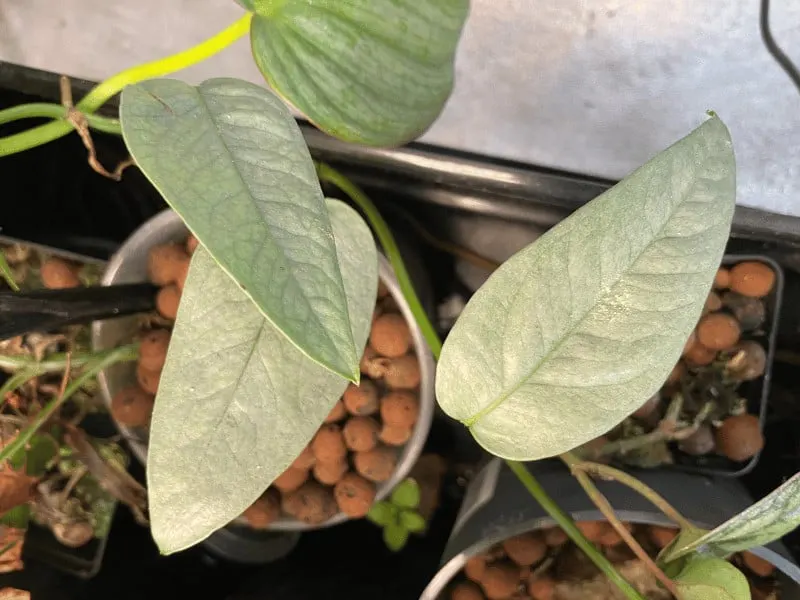
Is Monstera siltepecana toxic?
Monstera siltepecana is toxic to humans, pets such as cats and dogs. It contains insoluble calcium oxalate crystals. Ingesting any parts of this plant can lead to vomiting, diarrheae and stomach pain. It can also cause rashes on the skin, according to ASPCA.
Frequently Asked Questions
Where can I buy a Monstera siltepecana?
Monstera siltepecana is for sale on eBay, Etsy, from private sellers on Facebook or Instagram and online shops such as Ecuagenera and NSE Tropicals. These plants are rarely available in garden centers and regular offline plant shops.
What other Monstera types are there?
Monstera is a genus of about 50 species. Some other Monstera types in the genus are Monstera deliciosa, Monstera adansonii, Monstera esqueleto, Monstera subpinnata, Monstera lechleriana, Monstera dubia, Monstera pinnatipartita.
Does the Monstera siltepecana climb?
Monstera siltepecana is a bottom dweller at juvenile stages and starts to climb once it reaches the trunk of a tree or a rocky surface to climb. When caring for this plant indoors, provide a totem or moss pole so the Monstera siltepecana can attach its aerial roots to it and climb. You can also let it trail from a hanging basket.
Conclusion
Monstera siltepecana is an underrated and underhyped plant in the Monstera genus.
Like its more famous cousins the Deliciosa and Adansonii it is a climber or trailer that sets a tropical note in every apartment or house and is easy to care for. In addition, propagation is easy so it is a great plant to share, too.
Which form of Monstera siltepecana do you prefer?
The juvenile form with its nice silvery patched leaves and strong green veins or the adult form with its big holey leaves?
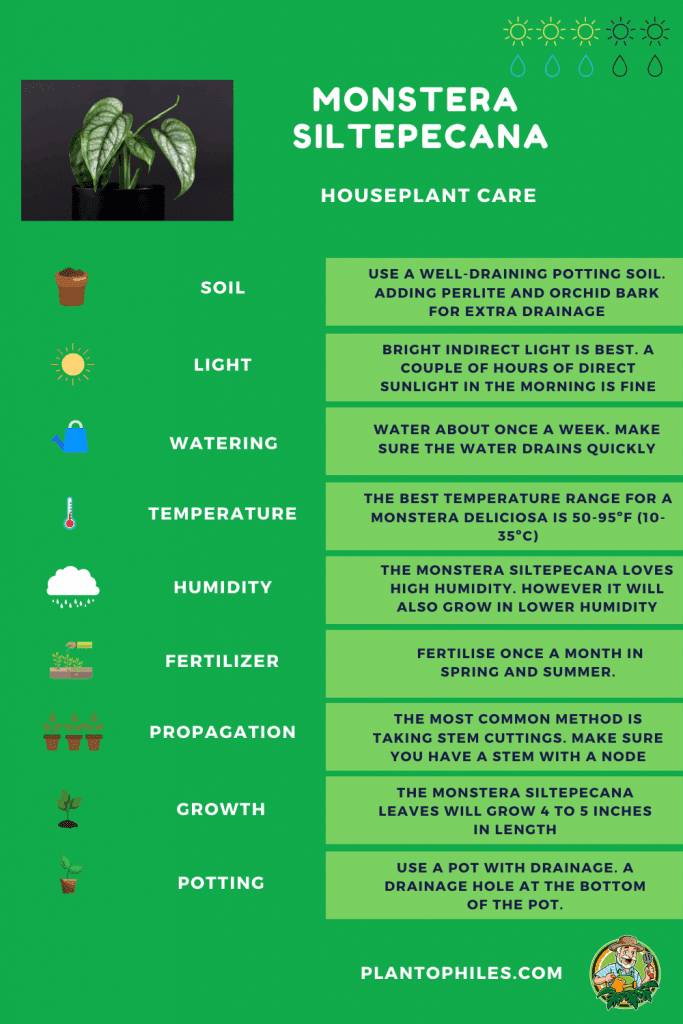

Daniel has been a plant enthusiast for over 20 years. He owns hundreds of houseplants and prepares for the chili growing seasons yearly with great anticipation. His favorite plants are plant species in the Araceae family, such as Monstera, Philodendron, and Anthurium. He also loves gardening and is growing hot peppers, tomatoes, and many more vegetables.

